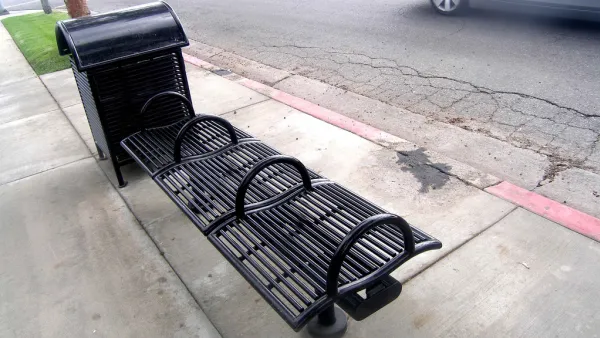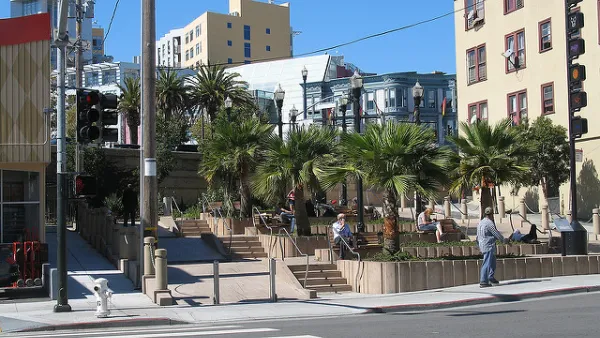A report by researchers at the University of California, Berkeley tracks the proliferation of vagrancy laws in the Golden State. Meanwhile, The Guardian notes the spread of so-called "defensive architecture."
The abstract of an interdisciplinary study out of the University of California, Berkeley explains the ugly history of vagrancy laws: "Vagrancy laws conjure up a distant past when authorities punished people without a home or permanent residence. Whether the objects of pity or scorn, vagrants could be cited or jailed under laws selectively enforced against anyone deemed undesirable. Although such laws have generally been struck down by courts as unconstitutionally vague, today’s 'vagrants' are homeless people, who face growing harassment and punishment for their presence in public."
The report "presents detailed evidence of the growing enactment and enforcement of municipal anti-homeless laws in recent decades as cities engage in a race to the bottom to push out homeless people."
Across the globe, Alex Andreou notes that urban design is increasingly becoming the physical arm of politics such as that described the study: "From ubiquitous protrusions on window ledges to bus-shelter seats that pivot forward, from water sprinklers and loud muzak to hard tubular rests, from metal park benches with solid dividers to forests of pointed cement bollards under bridges, urban spaces are aggressively rejecting soft, human bodies."
Andreou notes the public outcry over the use of "anti-homeless" spikes installed outside a London residential development last year, but also offers a more personal take, having been homeless in London in 2009 following a series of personal crises in conjunction with the economic downturn. Andreou's insights about basic shelter, gained from living homeless, stand in stark contrast to insights about "defensive architecture:
"Defensive architecture is revealing on a number of levels, because it is not the product of accident or thoughtlessness, but a thought process. It is a sort of unkindness that is considered, designed, approved, funded and made real with the explicit motive to exclude and harass. It reveals how corporate hygiene has overridden human considerations, especially in retail districts. It is a symptom of the clash of private and public, of necessity and property."

Analysis: Cybertruck Fatality Rate Far Exceeds That of Ford Pinto
The Tesla Cybertruck was recalled seven times last year.

National Parks Layoffs Will Cause Communities to Lose Billions
Thousands of essential park workers were laid off this week, just before the busy spring break season.

Retro-silient?: America’s First “Eco-burb,” The Woodlands Turns 50
A master-planned community north of Houston offers lessons on green infrastructure and resilient design, but falls short of its founder’s lofty affordability and walkability goals.

Test News Post 1
This is a summary

Analysis: Cybertruck Fatality Rate Far Exceeds That of Ford Pinto
The Tesla Cybertruck was recalled seven times last year.

Test News Headline 46
Test for the image on the front page.
Urban Design for Planners 1: Software Tools
This six-course series explores essential urban design concepts using open source software and equips planners with the tools they need to participate fully in the urban design process.
Planning for Universal Design
Learn the tools for implementing Universal Design in planning regulations.
EMC Planning Group, Inc.
Planetizen
Planetizen
Mpact (formerly Rail~Volution)
Great Falls Development Authority, Inc.
HUDs Office of Policy Development and Research
NYU Wagner Graduate School of Public Service




























